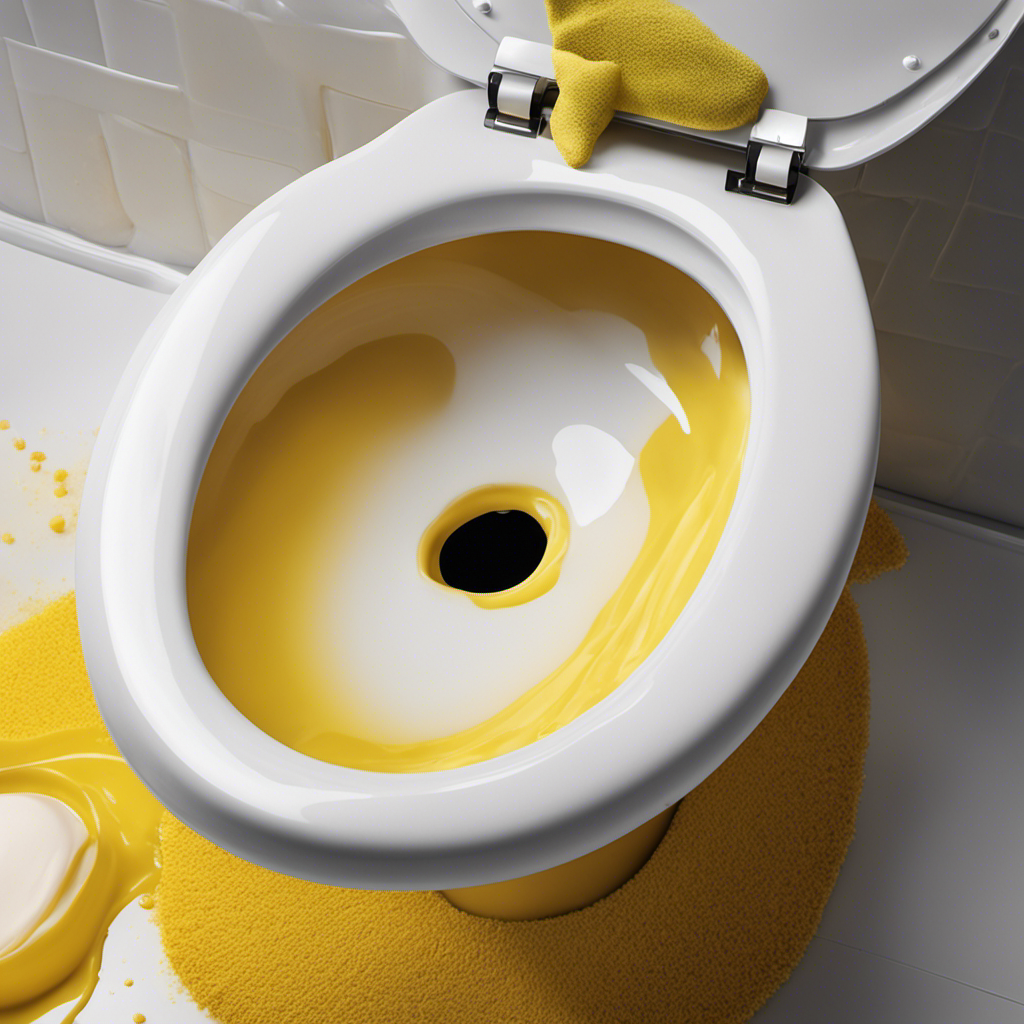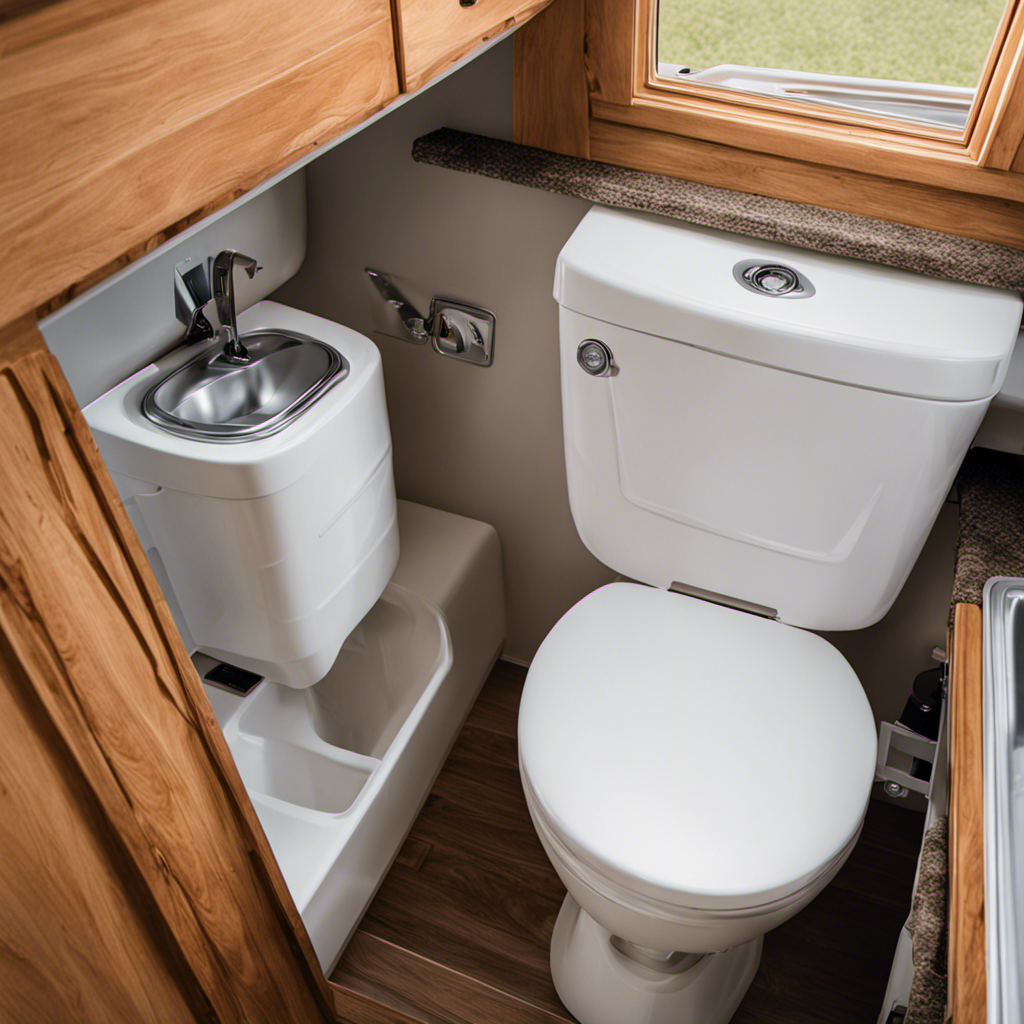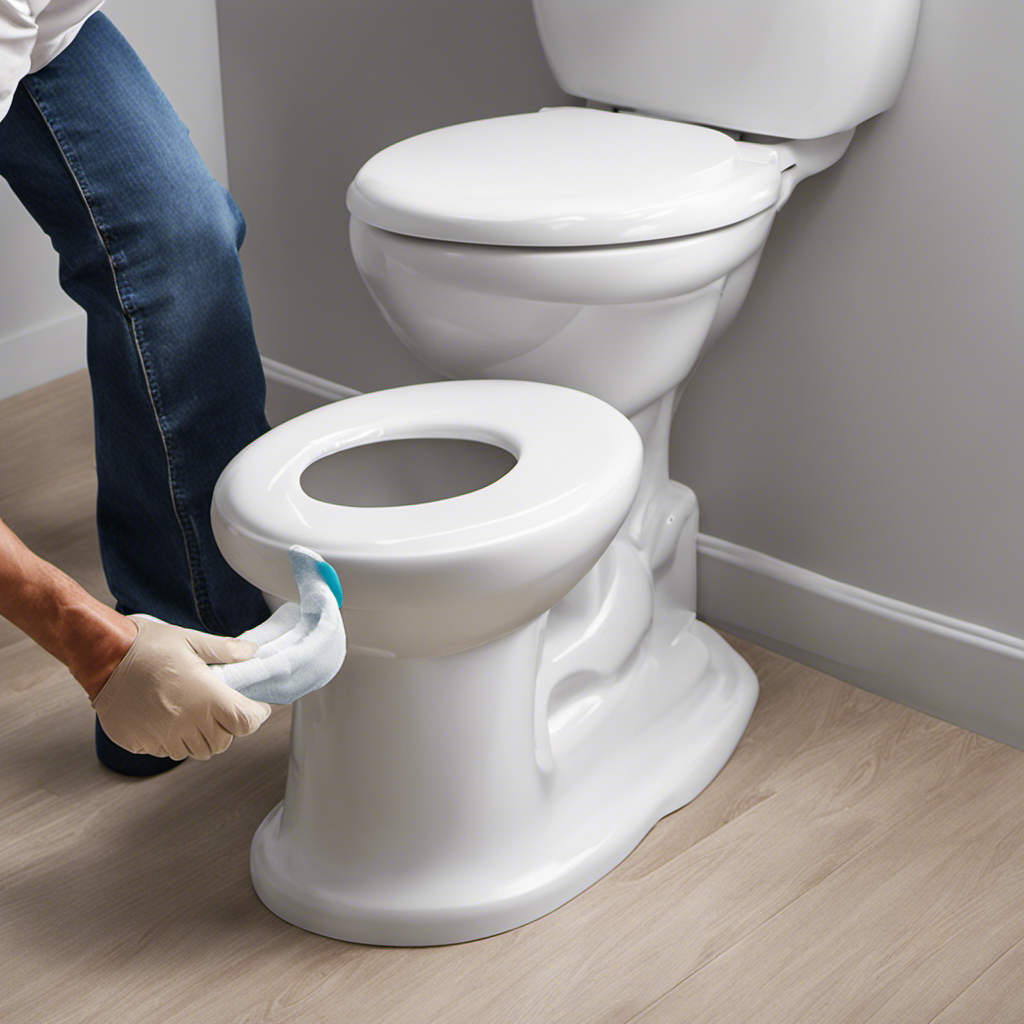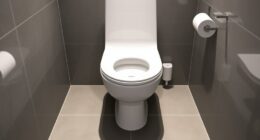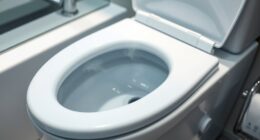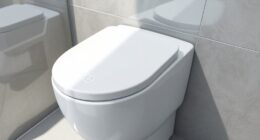Are you tired of staring at those unsightly yellow stains on your toilet seat? Well, fret no more! In this article, we will show you how to effectively remove those stubborn stains and restore your toilet seat to its former glory.
With just a few simple steps and some everyday cleaning supplies, you’ll have a sparkling clean toilet seat in no time. So, let’s dive in and say goodbye to those pesky yellow stains once and for all!
Key Takeaways
- Yellow stains on toilet seats are caused by hard water minerals and bodily fluids with high mineral and acid concentrations.
- Regular cleaning with mild cleaners and avoiding harsh chemicals can prevent yellow stains.
- Hard water minerals, like calcium and magnesium, are the most common cause of yellow stains.
- Regular maintenance and cleaning, along with fixing any leaks or drips, can keep the toilet seat free from yellow stains.
Understanding the Causes of Yellow Stains
Yellow stains on a toilet seat can be caused by a variety of factors. Understanding the chemistry behind these stains is crucial in preventing them from occurring.
The most common cause of yellow stains is the presence of hard water minerals, such as calcium and magnesium. These minerals can react with the chemicals in cleaning products, forming yellowish deposits on the toilet seat.
Additionally, urine and bodily fluids can also contribute to the formation of yellow stains due to their high concentration of minerals and acids.
To prevent yellow stains, it is important to regularly clean the toilet seat with a mild cleaner and avoid using harsh chemicals that can react with the minerals in the water.
Regular maintenance and cleaning can help keep your toilet seat free from unsightly yellow stains.
Gathering the Necessary Cleaning Supplies
Once you’ve got all the necessary cleaning supplies, it’s time to start tackling those stubborn toilet seat stains. Here are a few techniques you can try to remove yellow stains from your toilet seat:
-
Vinegar and Baking Soda: Create a paste by mixing vinegar and baking soda and apply it to the stained areas. Let it sit for a few minutes before scrubbing with a brush.
-
Lemon Juice: Squeeze fresh lemon juice onto the stains and let it sit for a while. Scrub the area with a brush to remove the stains.
-
Hydrogen Peroxide: Apply hydrogen peroxide directly to the yellow stains and let it sit for a few minutes. Scrub the area gently to remove the stains.
-
Borax: Mix borax with water to create a paste and apply it to the stained areas. Let it sit for a while before scrubbing with a brush.
These natural alternatives can effectively remove yellow stains from your toilet seat without the use of harsh chemicals.
Preparing the Toilet Seat for Cleaning
Before you begin cleaning, make sure you gather all the necessary supplies for preparing the toilet seat. Proper toilet seat maintenance requires the use of specific cleaning tools that are effective in removing stains and keeping your toilet seat clean and sanitary. Here is a list of essential cleaning tools you will need:
| Cleaning Tools | Purpose |
|---|---|
| Toilet brush | Scrubs away dirt and stains |
| Microfiber cloth | Wipes down the seat surface |
| All-purpose cleaner | Removes bacteria and germs |
| Rubber gloves | Protects your hands from cleaning chemicals |
| Spray bottle | Dispenses cleaning solution effectively |
Having these tools ready will ensure a smooth and efficient cleaning process. Once you have gathered all the necessary supplies, you can proceed to the next step of applying a homemade cleaning solution to remove yellow stains from your toilet seat.
Applying a Homemade Cleaning Solution
To effectively clean and sanitize your toilet seat, start by mixing a homemade cleaning solution using common household ingredients. Here is a step-by-step guide to help you remove yellow stains from your toilet seat:
-
Step 1: Gather the ingredients
-
Distilled white vinegar
-
Baking soda
-
Lemon juice
-
Water
-
Step 2: Create the cleaning solution
-
In a spray bottle, mix equal parts of vinegar and water.
-
Add a teaspoon of lemon juice for added stain-fighting power.
-
Shake well to ensure the ingredients are fully combined.
-
Step 3: Apply the solution
-
Spray the cleaning solution onto the stained areas of your toilet seat.
-
Let it sit for a few minutes to allow the solution to penetrate the stains.
-
Step 4: Scrub and rinse
-
Use a soft brush or sponge to scrub the stains gently.
-
Rinse the toilet seat thoroughly with water.
Scrubbing and Removing the Yellow Stains
When it comes to removing yellow stains from your toilet seat, you need to know the most effective stain removal techniques. Scrubbing the stains with a cleaning solution and a brush can help eliminate the discoloration.
Additionally, taking preventive measures can help prevent future yellowing and maintain a clean toilet seat.
Effective Stain Removal Techniques
If you want to effectively remove yellow stains from your toilet seat, try using a mixture of vinegar and baking soda. This powerful combination is a natural and cost-effective solution for stain removal.
Here are some tips to help you achieve the best results:
- Mix equal parts of vinegar and baking soda to create a paste.
- Apply the paste directly to the stained areas of the toilet seat.
- Let it sit for about 15 minutes to allow the mixture to penetrate the stain.
- Scrub the area gently with a brush or sponge, then rinse thoroughly with water.
By following these steps, you can effectively remove yellow stains from your toilet seat without having to rely on professional cleaning services.
However, it is important to note that regular cleaning and maintenance are key to preventing future yellowing.
Preventing Future Yellowing
Regular cleaning and maintenance are essential for preventing future yellowing of the toilet seat.
By following a few simple steps, you can keep your toilet seat looking clean and pristine for longer.
First, make sure to clean the seat regularly using a mild detergent or a toilet cleaner specifically designed for removing stains. Avoid using abrasive cleaners or brushes that could scratch the surface.
Additionally, wiping down the seat with a disinfectant after each use can help prevent discoloration caused by bacteria and other germs.
Remember to also check and fix any leaks or drips that could lead to water stains.
By incorporating these cleaning maintenance practices into your routine, you can keep your toilet seat looking fresh and prevent future yellowing.
Rinse and repeat for stubborn stains.
Rinse and Repeat for Stubborn Stains
To tackle stubborn stains on your toilet seat, make sure you rinse the area thoroughly and then repeat the cleaning process. This ensures that any loose debris or residue is removed before applying any cleaning agents.
Here are some effective cleaning techniques and natural stain removers to help you get rid of those pesky yellow stains:
-
Vinegar: Mix equal parts of white vinegar and water, then apply the solution to the stained area. Let it sit for a few minutes before scrubbing with a toilet brush. Rinse thoroughly afterwards.
-
Lemon Juice: Squeeze fresh lemon juice onto the stain and let it sit for about 15 minutes. Scrub with a brush and rinse well.
-
Baking Soda: Create a paste using baking soda and water, then apply it to the stain. Allow it to sit for 10-15 minutes before scrubbing and rinsing.
-
Hydrogen Peroxide: Apply hydrogen peroxide directly to the stain and let it sit for a few minutes. Scrub and rinse thoroughly.
Preventing Future Yellow Stains on the Toilet Seat
To prevent future yellow stains on your toilet seat, it is important to follow effective cleaning methods. Regularly cleaning the seat with a disinfectant cleaner and scrubbing it thoroughly will help remove any potential stains.
Additionally, practicing proper hygiene practices such as wiping the seat after each use can also help prevent the buildup of stains.
Lastly, using protective covers, such as toilet seat covers or plastic seat liners, can provide an extra layer of defense against stains and make cleaning easier.
Effective Cleaning Methods
If you want to effectively remove yellow stains from your toilet seat, try using a mixture of baking soda and vinegar. This natural cleaning solution is a great cleaning hack that can easily tackle those stubborn stains.
The combination of baking soda and vinegar creates a powerful cleaning agent that helps break down and dissolve the yellow discoloration on your toilet seat. Simply sprinkle baking soda on the stained areas and then spray or pour vinegar over it.
Let the mixture sit for a few minutes before scrubbing with a toilet brush. Rinse thoroughly with water, and you’ll be amazed at the results. Say goodbye to those unsightly yellow stains with this simple and effective cleaning method.
Proper Hygiene Practices
Maintaining good hygiene practices is essential for promoting overall health and well-being. To ensure cleanliness, there are a few key practices you should follow.
Start by regularly washing your hands with soap and water for at least 20 seconds. This helps prevent the spread of germs and reduces the risk of infections.
Additionally, it is important to keep your body clean by showering or bathing daily. Pay close attention to areas such as armpits, groin, and feet, as these tend to accumulate sweat and bacteria.
Furthermore, maintaining oral hygiene is crucial. Brush your teeth at least twice a day and floss daily to prevent dental issues.
Lastly, make sure to regularly clean your living space and frequently touched surfaces to maintain a hygienic environment.
Using Protective Covers
Using protective covers on frequently touched surfaces, such as doorknobs and light switches, can help prevent the spread of germs and maintain a hygienic environment. These covers act as a barrier, preventing direct contact with the surface and reducing the risk of contamination.
Here are some benefits of using protective covers:
- Germ protection: Covers create a barrier that prevents germs from transferring onto the surface, reducing the chances of infection.
- Easy maintenance: Protective covers are easy to clean and disinfect, ensuring a clean surface at all times.
- Durability: High-quality covers are made from durable materials that can withstand frequent use and provide long-lasting protection.
- Versatility: Protective covers come in various sizes and designs, making it easy to find the right fit for different surfaces.
When choosing a protective cover, consider factors such as material, ease of installation, and compatibility with the surface you want to protect. Ensure the cover is easy to clean and maintain to maximize its effectiveness in preventing the spread of germs.
Conclusion
Congratulations! You’ve successfully learned how to remove those pesky yellow stains from your toilet seat. Armed with the knowledge of the causes and the right cleaning supplies, you can now tackle this problem head-on.
By following the step-by-step process, you’ll be able to prepare the seat, apply the homemade solution, and scrub away the stains. This will leave you with a sparkling clean toilet seat. And don’t forget to rinse and repeat for those stubborn stains.
Say goodbye to yellow stains and hello to a pristine toilet seat!
